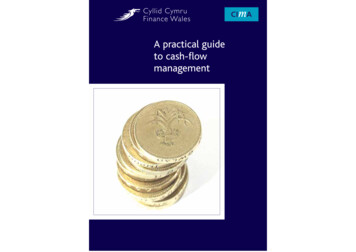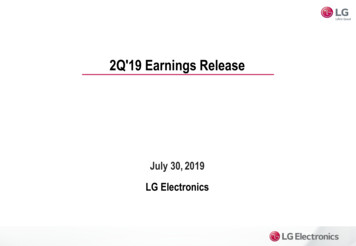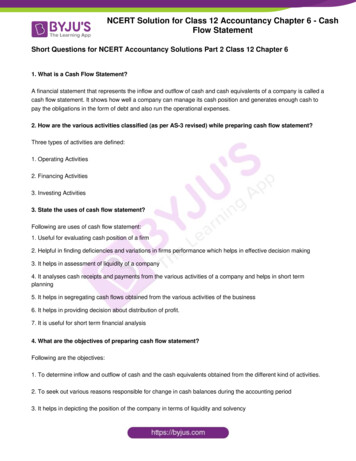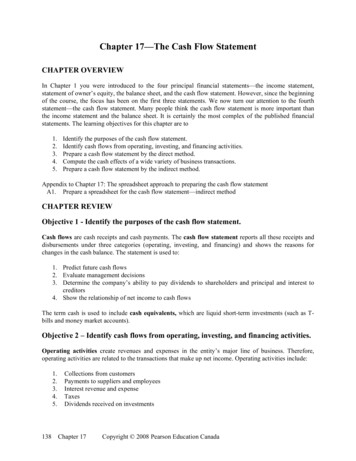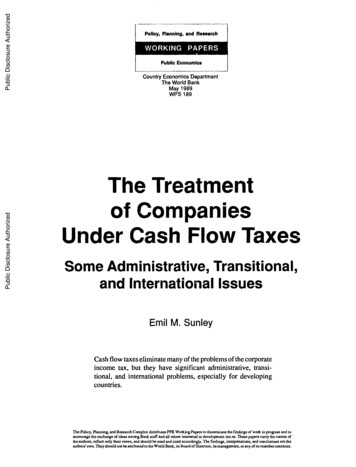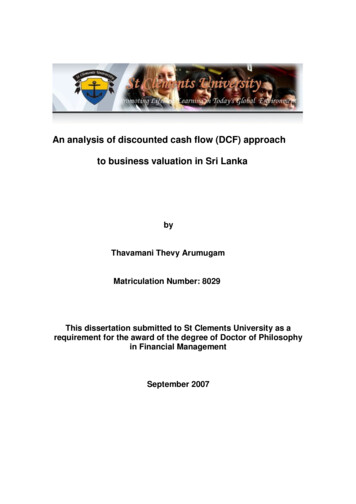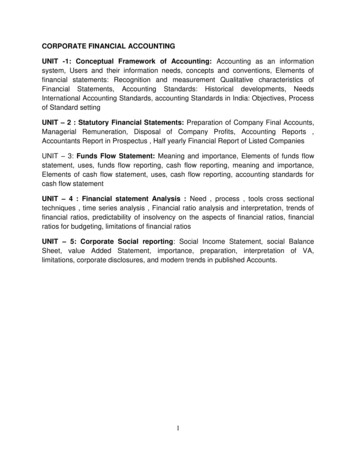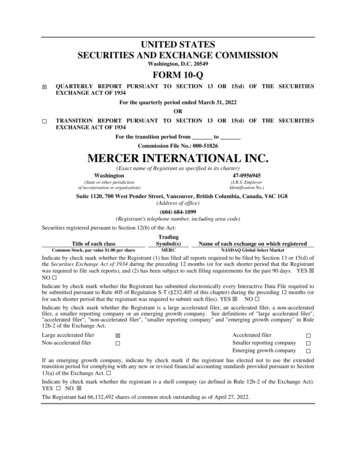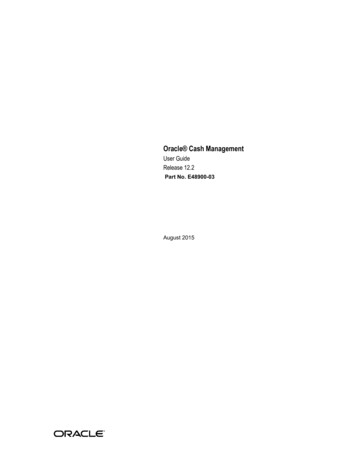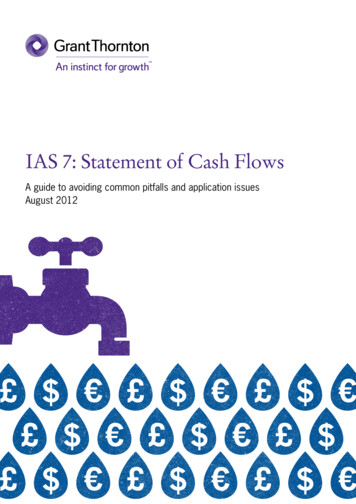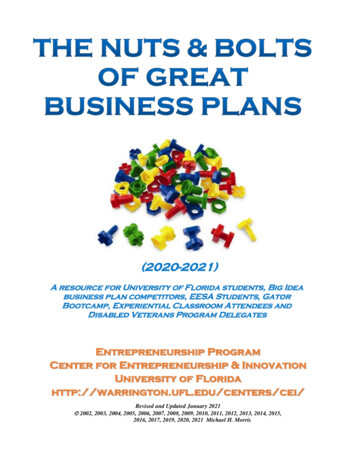
Transcription
FNAC CO9.QXD 12/10/05 10:29 am Page 154www.downloadslide.com154Financial Accounting9Cash flow statementsObjectivesBy the end of this chapter you should be able to: Explain the importance of cash flow within the business. Identify cash flows within a business. Prepare a cash flow statement. Explain the relationship between the cash flow statement, incomestatement and balance sheet within a business. Identify the difference between the indirect and direct method ofpreparing a cash flow statement. Identify and calculate a simple cash flow ratio. Explain the word ‘fund’ as used in accounting.IntroductionIn previous chapters we have concentrated on preparing financial information for a business based on the concept of profit. You should have alreadyrealised that profit does not equal cash and therefore it is quite possible for abusiness to be making reasonable profits but have very little cash. However,cash is vital to a business. Without it the business cannot purchase inventory, pay creditors, wages or any other expenses. Cash is quite often referredto as the ‘lifeblood’ of a business – without it it will not survive!A business therefore must pay attention to both its profit and cash position.Cash flows within a businessAt this point in your studies you should be able to complete the followingactivity quite quickly. If you do have problems return to Chapter 5 andconsider the cash transactions that Mr Bean made.
FNAC CO9.QXD 12/10/05 10:29 am Page 155www.downloadslide.com9 · Cash flow statementsActivity 9.1155Identify as many cash flows as you can for a business. Enter them in the tablebelow. Two are already entered for you.CASH FLOWSAnswerInto the business Capital contributed in the form of cashOut of the business Wages paid in cashCASH FLOWSInto the businessOut of the business Capital contributed in cash Wages paid in cash Cash sales Cash purchases Receipts from debtors Payments to creditors Cash loans and debentures Purchase of non-current assets Sale of fixed assets Cash paid for rent, heat, etc. Rents or other income received Dividends paid Interest and dividends received Interest paid Taxation paidYou have, in fact, just constructed a cash account and this is essentially what a cashflow statement is about.Remember what we said in Chapter 1 about a cash flow statement, whichwas that: Many accountants regard it as more objective and reliable than anincome statement. Cash flows are generally hard fact whereas assessment of profit requiresestimation and subjective judgement. It is much easier to manipulate profit figures than cash figures.The above factors are demonstrated in the following activity.Activity 9.2Alex Ltd has drawn up the following income statement for the first year of trading:SalesCost of salesGross profitDepreciationExpensesNet profit �––––––––––The following information is also available: The company started the year with 20,000 cash in the bank. Sales for cash throughout the year were 58,000 and cost of sales for cash 38,000. No debtors or creditors existed at the beginning of the year.
FNAC CO9.QXD 12/10/05 10:29 am Page 156www.downloadslide.com156Financial Accounting Of the expenses figure of 10,000, 1,500 has not yet been paid. The company acquired 15,000 of non-current assets during the year paying in cash.Identify: The cash figure at the end of the year and explain why this is different from theprofit figure. Cash inflows and outflows during the year. Any figures in the income statement that could be manipulated.AnswerOpening cashAdd cash salesDeduct: cash cost of salesCash expensesNon-current assets paid forClosing cash �––––Cash inflows were sales of 58,000Cash outflows were cost of sales of 38,000, expenses of 8,500 and purchase ofassets of 15,000, a total of 61,500.A net outflow of 3,500 has occurred. This is mainly due to the purchase of non-currentassets, which, remember, is not recorded in the income statement in the year of acquisition, but is spread over the useful life of the asset by means of a depreciation charge.The profit figure above of 10,000 can be changed if different assumptions are madeabout the depreciation charge.In the above activity Alex Ltd is profitable but if, to remain in business, ithad to purchase 50,000 of non-current assets, or if it had to repay a loanof 50,000 immediately after the end of the year then it would not haveenough cash to do this and would need to organise an overdraft facility.The future of the business depends, to a large extent, on its cash positionand its ability to generate cash to pay off the overdraft. As cash is so important to businesses they are required to prepare a cash flow statement whichidentifies the cash position of the business at a point in time and theinflows and outflows of cash for the users of the financial statements.Using the above activity we can also calculate a very simple cash flowratio. You will learn more about ratios and ratio analysis in Chapter 11, butit is useful to deal with this one ratio at this stage. Ratios can help us tointerpret/analyse the information in a set of financial statements. From theabove activity we can calculate a ratio of total cash inflows divided by totalcash outflows; 58,000/61,500 0.94. This is close to 1, indicating that ourinflows have almost matched our outflows and we have been able to purchase some non-current assets.
FNAC CO9.QXD 12/10/05 10:29 am Page 157www.downloadslide.com9 · Cash flow statements157Cash flow statementAccountants prepare cash flow statements to a given format prescribed bythe International Accounting Standards Board in IAS 7. This format incorporates all the items you have listed in Activity 9.1 above, but identifiescash flows under specific headings as follows:CASH FLOW STATEMENT FOR THE YEAR ENDED XXNet cash inflow/outflow from operating activitiesInterest paidTaxation paidNet cash used in investing activitiesAcquisition of subsidiary less cash acquiredPurchase of non-current assetsProceeds from sale of non-current assetsInterest receivedDividends receivedNet cash used in financing activitiesProceeds from issuing sharesProceeds from long-term borrowingDividends paidIncrease/Decrease in cash and cash �––X––– X––––––One item on this cash flow statement, the net cash inflow/outflow fromoperating activities, does not equate directly to an item on the cash account.We will explain how this figure is derived later in this chapter. To familiariseyourself with the cash flow format, work through the following activity.Activity 9.3The following information is available in respect of White Rose Ltd for the year end31.12.X5: Net cash inflow from operating activities was 120,000. The company received dividends during the year of 45,000, paid an interim dividend of 30,000 and proposed a dividend of 20,000 at the year end. Lastyear’s proposed dividend was 25,000. The taxation charge for the year was estimated at 55,000 which was 3,000less than that estimated for the year ended 31.12.X4. Interest was payable during the year on 200,000 of 5% debentures. All interestdue had been paid at the year end. White Rose Ltd had purchased 120,000 of fixed assets during the year to31.12.X5 and fixed assets sold had produced a profit on sale of 10,000. Thenet book value of fixed assets sold was 50,000.
FNAC CO9.QXD 12/10/05 10:29 am Page 158www.downloadslide.com158Financial Accounting White Rose Ltd had also issued 50,000 1 ordinary shares at a premium of 50p.All shares were fully paid at the year end. A loan of 40,000 had also been raisedby the company at the same time as redeeming loans of 20,000 at par.Prepare the cash flow statement for the year ended 31.12.X5 (NB: There wereno acquisitions or disposals of subsidiaries.AnswerCASH FLOW STATEMENT FOR THE YEAR ENDED 31.12.X5Net cash inflow/outflow from operating activitiesInterest paidTaxation paid 120(10)(58)–––––Net cash used in investing activitiesAcquisition of subsidiary less cash acquiredPurchase of non-current assetsProceeds from sale of non-current assetsInterest receivedDividends received(120)60Net cash used in financing activitiesProceeds from issuing sharesProceeds from long-term borrowingRepayment of debenturesDividends paidIncrease/Decrease in cash and cash ��– 52(15)40––––– 77––––––––––In completing this activity care was required when dealing with the following items toensure that the cash flow was identified: Dividends proposed at the year end 31.12.X5 were not paid but the proposed dividend from the previous year was. Tax is not due until nine months after the end of the year so the tax paid is lastyear’s liability. The actual receipt from the sale of assets was the cash flow not the profit on salewhich is the figure included in the income statement. The cash flow from the issue of shares included the share premium.Net cash flow from operating activitiesThis item refers to cash flows in respect of buying and selling goods andexpenses incurred. It can, of course, be derived from the cash book by identifying all cash receipts from trading and all cash payments such aspayments to trade creditors, payments for wages, rent, rates, electricity andso on. This would be the direct method of arriving at the net cash flowfrom operating activities. However, it can also be derived from the incomestatement for the year.
FNAC CO9.QXD 12/10/05 10:29 am Page 159www.downloadslide.com9 · Cash flow statements159Activity 9.4Identify as many items as you can that appear in the income statement before interest,taxation and dividends that do not involve a flow of cash.Answer Depreciation – a book entry not a flow of cash. Profit or loss on sale of assets – the cash receipt of sale price is the cash flow. Accruals and prepayments – income and expense within the income statement is recognised in accordance with accounting concepts. It is not the cash receipt and payment. Sales (cash sales and sales on credit) – the cash flow is cash sales and receiptsfrom debtors. Cost of sales (cash and credit purchases adjusted for opening and closing inventory) –the cash flow is the cash spent during the year on purchases and payments to creditors.Another method, in contrast to the direct method, of arriving at the netcash flow from operating activities would be to adjust the operating profitbefore taxation, interest and dividends for all the items listed in the answerto Activity 9.4. This is known as the indirect method. IAS 7 actually prefersthe direct method as it provides information which may be useful in estimating future cash flows which is not available under the indirect method.It does however permit the use of the indirect method as it can be easilyderived from the income statement.The reconciliation of operating profit and net cash flows from operatingactivities is required as a note to the cash flow statement. The note is formatted as follows:Reconciliation of operating profit and net cash flows fromoperating activities:Operating profit (as per income statement)Adjustment for items not involving themovement of fundsDepreciationX(Profit)/loss on sale of assets(X)AmortisationXX(Increase)/decrease in inventory(Increase)/decrease in debtors(Decrease)/increase in creditorsXXX––––Net cash inflows from operating activitiesX–––– X––––––––Note in the above that: Depreciation and amortisation charges are added back to the operatingprofit as these were deducted in arriving at the profit figure. Amortisationis the term used to describe the depreciation of leases. Profit on sale is deducted.
FNAC CO9.QXD 12/10/05 10:29 am Page 160www.downloadslide.com160Financial Accounting Decrease in inventory and debtors from last year to this is added to theoperating profit as this means less cash has been tied up in inventories anddebtors. Conversely an increase would mean more cash had been tied up. An increase in creditors is also added back to the profit figure as thismeans cash has been kept in the business not paid out to reduce the liability to creditors.The direct method of arriving at net cash flows from operating activities isformatted as follows:Cash received from customersCash paid to suppliersCash paid to and on behalf of employeesOther cash paymentsNet cash inflow from operating activitiesActivity 9.5X(X)(X)(X)–––– X––––––––The following information is available in respect of Red Rose Ltd for the year ended31.12.X5.INCOME STATEMENT EXTRACT FOR THE YEAR ENDED 31.12.X5Net profitNet interest ––––– 35––––––––––Net profit before taxationTaxationNet profit after taxationDividends paid and proposedRetained profitNet profit of 120 is after charging depreciation of 25 and including loss on sale ofassets of 15.BALANCE SHEET EXTRACTSInventoryDebtorsCashCreditors31.12.X4 852––––15731.12.X5 623––––138Prepare the reconciliation of operating profit to net cash flow from operating activities.
FNAC CO9.QXD 12/10/05 10:29 am Page 161www.downloadslide.com9 · Cash flow statementsAnswerNet profit before interest and taxationAdjustments for items not involving the movementsof fundsDepreciation25Loss on sale15–––Decrease in inventoryDecrease in debtorsIncrease in �–––– 164––––––––––Purpose of cash flow statementThe cash flow statement provides information in addition to that providedby an income statement and balance sheet. It identifies the cash flows in abusiness which are not apparent from the other two statements. It alsoidentifies whether cash has increased or decreased from one year to thenext. It does, however, have several drawbacks, some of which it shareswith the other statements.Activity 9.6AnswerIdentify two drawbacks of a cash flow statement.Several clues have already been given to you to answer this question. You should haveidentified two from the following: Cash is the ‘lifeblood’ of an organisation but the cash flow statement is historical. Ifwe are concerned over the liquidity of a business, the ability to pay its debts, then acash flow forecast would be more useful. Cash flow from operating activities is derived by either the direct or indirect method.The indirect method uses information from the accruals-based accounting system. Ifcash flow is what we are interested in then there should only be one alternative –the direct method. This would also avoid confusion for users who may have difficultyin understanding the reconciliation between operating profit and cash flow. What is cash? Is it cash in the shop till, cash in the bank, short-term investments?Just what do we mean by cash?Funds flowThis section will provide you with an answer to the last question raised inthe answer to Activity 9.6.We have already looked at the idea of funds in Chapter 2, which identified the concept of funds coming into and out of the business – sourcesand applications. Sources of funds were such items as profit from trading,
FNAC CO9.QXD 12/10/05 10:29 am Page 162www.downloadslide.com162Financial Accountingcapital invested and loans taken out. Applications were the purchase ofnon-current assets and investments. Funds were not necessarily cash funds.In Chapter 11 you will meet the phrase ‘return on shareholders’ funds’.These funds are the total of share capital and reserves, which are certainly notrepresented solely by cash. Shareholder funds are represented by the business’snet assets, that is, non-current assets and current assets less current liabilities.In general, in accounting the word ‘funds’ is used in connection with theaccruals-based accounting system. It is possible to prepare a statement ofsources and applications of funds for every business. In fact, prior to theintroduction of the cash flow statement requirement businesses did preparesuch a statement. The statement, instead of arriving at a figure showing theincrease/decrease in cash balances, showed the change in working capital –the funds flow. Working capital is the difference between current assets andcurrent liabilities including accruals and prepayments. It is quite feasible fora business to have a net inflow of funds, as defined in terms of working capital, but an actual net outflow of cash. This is demonstrated by thefollowing example.BALANCE SHEET EXTRACTSInventoryDebtorsCash31.12.X4 128631.12.X5 ��––––––Increase in working capital (19 – 14)Decrease in cash (6 – ��51The move away from preparing source and application of funds statementsto that of preparing cash flow statements is regarded by many as being animportant step forward in the provision of useful information.Activity 9.7Identify two reasons why cash flow statements may be regarded as more useful thanfunds flow (working capital) statements.AnswerYou should have identified two of the following: Cash is more objective and verifiable. It is not blurred by estimates of accruals andprepayments. Cash is more easily understood by users. Cash flow is a better guide to a business’s ability to pay its liabilities than a funds flow. Working capital is not an indication of the solvency of a business.
FNAC CO9.QXD 12/10/05 10:29 am Page 163www.downloadslide.com9 · Cash flow statements163Cash and cash equivalents, for our cash flow, still needs to be defined. In general,cash is determined as cash on hand and all deposits payable on demand. Depositspayable on demand are defined as those that are easily convertible into cash and canbe withdrawn at any time without notice and without penalty. Don’t forget that overdrafts repayable on demand will also have to be taken into account. Cash equivalentsrefers to short-term investments. Investments are viewed as short term if the maturitydate is within three months or less from the date of acquisition.Activity 9.8Determine whether the following items are cash, cash equivalents, investing activities or financing activities;1 An account held with a bank where a withdrawal requires 80 days’ notice2 An account held with a bank where a withdrawal requires 150 days’ notice3 An overdraft with the bank which is seen as short term and part of everyday cashflows of the business4 A loan from a bank for 75 days for a specific purpose5 An investment with the bank which has 60 days to maturity but its final valuepayable fluctuates in accordance with stock market valuesAnswer1 This can be viewed as short term and therefore cash equivalent2 This is really a long-term investment as far as cash flows are concerned and therefore part of investing activities3 This is cash4 This is financing activities as a loan for a specific purpose cannot be viewed aseveryday cash management5 There is a significant risk with this investment and therefore it should be viewed aspart of investing activitiesRelationship between the cash flow statement, income statementand balance sheetIn the preparation of cash flow statements so far in this chapter, you havebeen given the information required. However, some of this informationcan be deduced from the income statement and the opening and closingbalance sheets. For example, you should be able to identify the increase inshare capital from the opening and closing balance sheets. The followingexample illustrates the connections between the three statements anddemonstrates the preparation of a cash flow statement by using information from the other two plus additional information.
Prepare a cash flow statement. Explain the relationship between the cash flow statement, income statement and balance sheet within a business. Identify the difference between the indirect and direct method of preparing a cash flow statement. Identify and calculate a simple cash flow ratio. Explain the word 'fund' as used in accounting .
